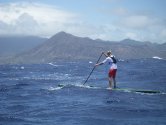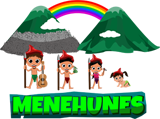2009 Molokai Channel Crossing Mental Notes from Robert Stehlik
Here’s some good insights from Robert Stehlik on his Molokai Channel Crossing experience.
My wife asked me after the Molokai race: “What were you thinking about for those six hours?” My reply: “I was trying not to think about anything.”
’nuff said…
I had several more people ask me what was going through my head during the Molokai crossing, so while it is still fresh in my mind, I will write down some thoughts on the mental aspect of the crossing. So, if the short answer above is not enough for you, read on.
Focus:
One of the most important aspects in Stand Up Paddling is maintaining balance. To achieve peak performance it is critical to stay focused. Keeping my focus sharp for the 6+ hours it took to complete the 32 mile race was a big challenge for me. Focus is important in every sport. In surfing for example you need to be fully focused when you are catching and riding the wave but when you are paddling back out or waiting for the next set you can let the mind wander, daydream, talk story or whatever without major consequence as long as you can turn off the chatter and fully focus when you swing the board around to catch the next wave. When you are racing on a SUP you need to stay focused the whole time, which is easier said than done.
Training:
When my mind starts to wander I slow down, miss bumps and/or loose my balance and fall in. One of my goals in training was to work on keeping focused and balanced. Doing long distance paddle sessions for five or more hours prepared me for the race endurance wise but was also important to train the mind to stay focused for a long time.
Music:
Many paddlers use waterproof MP3 players to allow them to relax. I have tried this and found that it makes the session more fun and does help me relax. I decided not to take music with me for these reasons:
1) It’s more equipment to deal with- I like to keep things as simple as possible.
2) I found that it can be distracting- for example: songs can trigger memories, the earphones get loose or start to be irritating, I’m in the mood for different music, batteries go dead, etc.
3) It’s a crutch- I find that although it helps, I don’t need music to relax and focus.
I know that it works for others. Jamie Mitchell, 8 times Molokai champion cruises to his itunes and it obviously works for him- so don’t take my word for it, try what works for yourself.
Relaxed Focus:
This was my mantra that I kept repeating to myself during the race. I tried to keep my mind clear and when I noticed I was losing my focus or having distracting thoughts, I would repeat this in my head along with some other words I would repeat to myself.
Relax Plenty
It was the first time I did the Molokai crossing and I was not sure exactly what to expect. I started out at a steady pace that I knew I could keep up for the whole race. I kept thinking about something Aaron Napoleon said about going downwind and catching bumps. He said something like- I see some guys paddling so hard non stop, when I ride bumps I relax plenty.
I have a lot of respect for Aaron, he is one of the fastest guys in the water, low key and a super tough waterman. So I have this recording of Aaron in his pidgin saying: I relax plenty and kept playing it to myself. There were lots of bumps to ride and the easterly winds made for good bump riding. I kept taking a few hard strokes and then relaxing, getting long gliding rides and making good time. I felt strong and relaxed and I actually thought I should push harder or I would not feel totally exhausted by the finish line.
Glide:
I did not repeat this word to myself but it was my goal- to glide, so I’m putting it in here.
I think this is the key to doing well in the Molokai race. If you counted all the strokes each paddler took, I’m sure that the winner, Ekolu Kalama, crossed the channel with less strokes than any other paddler by gliding more and paddling less.
The last 5 miles:
Todd Bradley told me- The race does not really start until the last 5 miles. Although I had trained for the tough finish and paddled around Portlock Point many times, I did not really understand what he meant until I had to do it myself. The water got choppy, there was a current and it became more and more difficult to catch bumps. Dave Parmenter described it as going through quicksand which is exactly what it felt like to me.
Distractions:
I did not see any other solo paddlers (we had white shirts) for the whole race until right before Portlock point, when Jenny Kalmbach from the Big Island caught up to me. She was paddling strong and I was running out of steam. I lost my relaxed focus and just tried hard to keep up with her pace. My forearm muscles felt tight and started cramping. Negative thoughts started filling my head. I fell in and as I got back up on the board my abdominal muscles cramped up, something that has never happened to me before. I hit myself in the stomach to loosen up the cramp, then tried to stretch. I finally loosened up and kept going. I knew I could not keep paddling at Jenny’s pace but I also knew that once I got close to China Walls I would be able to catch some waves and stay close to shore, I had practiced this many times, so I just had to get there. I tried to relax and just focus on catching bumps. The waves were disorganized and choppy but there were still some bumps to catch and by focusing on using every little push, I was able to make steady progress while conserving the little strength I had left.
Relief:
I got to China Walls and was pushed in by a couple of waves, then snuck through the reef pass without losing my board and felt a great sense of relief. Almost there. I caught a couple more waves and stayed close to shore. I did it, just a little more! Finishing this race was a huge accomplishment for me and it felt great.
Now What?
Another interesting thing is how I felt a couple of days after the race. I put so much time and energy into this goal and finally accomplished it. So now what? I had neglected many things in my day to day life (yes, I work and have a family and am not a professional athlete) to prepare for the race and now was the time to get caught up with everything. I was stoked and proud but I found myself feeling tired and frustrated, I did not feel like getting caught up on my to do list at all, or anything, really, I just wanted to be a couch potato, which made me feel worse. Luckily that did not last long. I started training for the Duke’s race which is coming up soon and am applying some of my energy and persistence towards work and the goals I have for my business. I’m also setting a goal for next year’s Molokai race, maybe I’ll see you there.
Aloha,
Robert Stehlik
www.BluePlanetSurf.com
You may also check out Robert Stehlik’s blog at Zen Waterman







Whether it be SUP, paddleboarding, canoe paddling (one-man or six-man), the Molokai crossing is truly a Man (or person) Against The Sea experience for sure. Gerry Lopez mentioned that he now knows why he never did this race. Speaking of Gerry, and maybe one of the reasons that one tries these “adventures,” check out his mission statement he wrote for SRF (Surf Realization Fellowship), an underground movement in Hawaii, at http://www.srfhawaii.com.